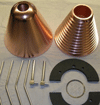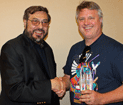
|
Director’s Corner: Helping Build LBNL’s Future While Contributing Across the DOE Complex
|
DIRECTOR’S CORNER

|
Helping Build LBNL’s Future While Contributing Across the DOE Complex
|
|
Our vision: transformational R&D as we invent, develop, and deploy accelerators
and photon sources with which to explore and control matter and energy.
| Most of our work serves the DOE’s Office of Science. Its guidance and the reports of blue-ribbon committees like the Particle Physics Project Prioritization Panel help us make sure our efforts are aligned with agency priorities and the needs of the research community.
Major areas of endeavor include service to programs in Basic Energy Sciences, High Energy Physics, and Nuclear Physics. However, we reach out widely to other DOE offices, other agencies, and university and industrial partners, getting the most possible benefit out of agency investment in our capabilities. |

|
That collaborative spirit of team science with multi-institutional teams, along with cooperation with universities and industry, are longstanding traditions going back to the deepest roots of the Division. Our efforts can be thought of in three overlapping main areas: contributing to today’s national and international priorities; strengthening and reinventing LBNL’s own facilities; and discovery science and technological innovation.
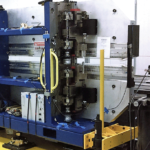
|
ATAP (often in close partnership with the Engineering Division) is contributing to today’s national and international priorities on several fronts by developing technology and bringing design and analytical expertise to bear. We are proud to be the partner of choice for some of the most difficult aspects of forefront accelerators across the US and worldwide—a capability that can only come from a strong foundation in the fundamentals of accelerator science and technology.
In this issue, we invite you to read about one of the most important of these partnerships: our role in LCLS-II. Future issues will bring much more on these topics. |
|
Strengthening and reinventing LBNL’s own facilities is a key role of ATAP. Six Labwide strategic initiatives have been articulated by LBNL Director Michael Witherell in the Laboratory Plan, and ATAP is crucial to three of them: the Advanced Light Source Upgrade, exploration of future accelerators, and exascale computing for science.
ALS-U: Preparing for Another 20 Years at the Forefront

|
ALS-U, a proposal for building an entirely new accumulator and storage rings within the existing building, has been described by a Basic Energy Sciences Advisory Committee subcommittee as an “absolutely central” element of DOE’s light-source portfolio, an element that is “ready to initiate construction.” We have submitted a proposal and are awaiting Critical Decision Zero, the official statement of mission need, from the Department of Energy, whereupon a phase called conceptual design—progressing from the concept to how all aspects should be engineered and built—can begin. Future issues of this newsletter will highlight the status and science and technology progress of ALS-U. |
The Smaller, More Cost-Effective Accelerators of the Future
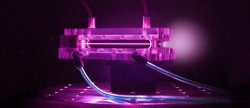
|
ATAP is leading another Labwide priority: future accelerators. Laser-plasma accelerators, a technology that BELLA Center has been developing, have enjoyed breakthroughs in recent years, such as our recent demonstration of “staging” or coupling of beam from one accelerating stage into another. LPAs are poised for further progress in both technique and enabling technologies. Our initiatives and spinoff prospects will be the subjects of more articles in the coming months. The work is driven by national level planning efforts such as the recently released Advanced Accelerator Development Strategy Report. | |
Taking Accelerator Modeling to the Exascale
We also figure into a third Labwide strategic priority: exascale computing for science. The exascale, a thousandfold improvement over today’s computing capability, can transform many fields of science, including modeling and simulation of accelerators. Plasma-based accelerators such as those being developed by BELLA Center, a remarkably promising technology still in early days, will especially benefit. Developing plasma-based accelerators into mainstream particle acceleration tools depends critically on high-performance, high-fidelity modeling to capture the complexity of processes that develop over a large range of space and time scales.

|
Advanced modeling, often in conjunction with the Computational Research Division and the National Energy Research Supercomputing Center (NERSC), is already a strength of ATAP and a common theme across many of our activities. We have one of the 20 projects included in the NERSC Exascale Science Applications Program (NESAP), a partnership among NERSC, Cray and Intel. We are also a partner in the SciDAC ComPASS project, as well as in CAMPA, the emerging Consortium for Advanced Modeling of Particle Accelerators, which spans multiple laboratories to bring their advanced computational tools to the overall Office of Science mission. The power of exascale computing will be a game changer for our ability to maximize the potential of familiar types of accelerators and explore the potential of the innovations now being developed. Here, too, stay tuned as we focus more on these efforts in upcoming issues. | |
Discovery science and technological innovation is the third major theme of ATAP’s efforts, crosscutting and underpinning all the others.
We’ve already mentioned our work in advanced accelerators and radiation sources. Advanced magnets, long a strength of ATAP, are another important area of technological innovation that enables discovery science.

|
To serve the needs of future colliders and other scientific instruments, DOE has named LBNL the lead laboratory of the upcoming US magnet development program. The program — in which we are partnered with Fermilab and the National High Magnetic Field Laboratory at Florida State University, as well as other institutions engaged in R&D relevant to high-field magnets — is described in a just-published document.
I have appointed Stephen Gourlay, head of the Berkeley Center for Magnet Technology, to lead this effort, which focuses on transformational magnet technologies for high-energy physics applications and will have high leverage for other fields. |
|
ATAP is poised to apply its capabilities to one of its longtime endeavors — the quest for fusion energy — in multiple ways. One of them is in the area of burning plasma science; the structural evolution of fusion materials could be studied with NDCX-II’s intense pulsed ion beams and high power density pulsed plasmas.
Something that all of these diverse efforts have in common is highly skilled, innovative people at all phases of their careers. In recent months we have welcomed 8 new postdoctoral appointees to ATAP, bringing our total to 14—part of our tradition of hosting 20-30 students of all levels and 10-20 postdocs at any given time. Not only do we recruit and train top people, but we give them an environment where they find lasting value and opportunity, as shown by the 30-year service milestones reached this year by four of our employees.
It is an honor to lead people of such skill and dedication, and I look forward to what we will accomplish in the coming year.
LBNL TO LEAD NATIONAL MAGNET DEVELOPMENT PROGRAM
— LBNL-led R&D multi-laboratory campaign toward needs of future colliders
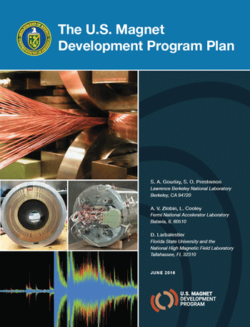
|
Progress in accelerators has always gone hand in hand with the achievable strength and quality of magnets. As we look toward upgrades of the Large Hadron Collider and beyond it toward a notional future circular collider, pushing magnets beyond the present state of the art — not only in field strength and quality but in cost per tesla-meter — looms even larger in importance. Many other disciplines, from charged-particle therapy to fusion energy, would also benefit from these advances.
These needs were stated by the Particle Physics Project Prioritization Panel (P5), as well as by the Accelerator Technology Subpanel of the High Energy Physics Advisory Panel (HEPAP), two blue-ribbon committees that help guide US programs in high-energy physics. In response, the DOE Office of High Energy Physics has initiated an ambitious program to aggressively pursue the development of superconducting accelerator magnets that operate as closely as possible to the fundamental limits of superconducting materials and at the same time minimize or eliminate magnet “training” — the need to break in a magnet in a series of steps to achieve its design field strength. |
LBNL has been named as the leader of this R&D program, partnering with Fermilab and the National High Magnetic Field Laboratory at Florida State University, with opportunities to come for additional partners engaged in R&D relevant to high-field magnets. Glen Crawford and Michael Procario of the DOE Office of High Energy Physics noted in chartering the effort that LBNL is “expected to take the lead role with the U.S. accelerator research community in… high-field magnet R&D that can enable far-future energy frontier colliders… with energies significantly greater than the full energy of the LHC.”
Wim Leemans, Director of the Accelerator Technology & Applied Physics Division, has named Stephen Gourlay, head of the Berkeley Center for Magnet Technology, as leader of the new national magnet development program.
The importance of stronger, better, and more cost-effective magnets has long been recognized and pushed forward in ATAP, in close partnership with the Engineering Division. “For years, the Berkeley Lab has excelled at developing magnet technologies,” says James Symons, Associate Laboratory Director for Physical Sciences. “This is an area where traditionally we have been very strong.”
Leemans adds, “Our program has an unbroken series of field-strength records, and what’s more, they’ve done that with a series of different technologies, always innovating.”
The other charter members of the partnership have strong capabilities and distinguished achievements of their own, making for a powerful and well-rounded combination. “With the combined resources and infrastructure of the MDP partners, we have an extraordinary opportunity to take the U.S. leadership in high field superconducting magnets to an unprecedented level,” adds Gourlay.
To Learn More…
Download the Magnet Development Program Plan, which lays out the motivation and course of action for this ambitious program as it works toward its goals of transformational R&D.
LCLS-II GUN, SXR, HXR EFFORTS PHASE INTO PRODUCTION
— Prototyping for LLRF; Design Progress for HGVPU; Modeling Results Praised by Reviewers
The SLAC-based multi-laboratory project to build LCLS-II, a next-generation free-electron laser light source, requires the collaborators to meet state-of-the-art challenges in accelerator physics and technology from end to end. LBNL has crucial responsibilities in the project, including two major deliverables: the injector source and the two FEL undulator arrays, one each for hard and soft X rays.
We contribute as well to accelerator physics and technology studies in beam dynamics, FEL design, low-level RF, and management and integration of cryogenics systems. Production is under way in most of our areas of responsibility.
Injector Source Moves Cleanly Out Of Design Phase
The electron gun and the photocathode load-lock systems, and the low-energy beamline, recently went through Final Design Review and then, this month, a Production Readiness Review that examined planning and quality assurance for successful delivery of the gun. Thus the injector source systems progressed from the design phase and into production, and are fully integrated with other parts of the overall injector system that are the responsibilities of SLAC and Fermilab.
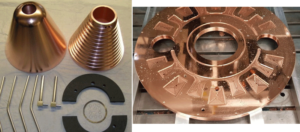 |
After successful final design and production readiness reviews, the LCLS-II gun program is cutting metal. Far left: components of the gun nose being prepared for brazing. Left: cathode wall end plate being machined. Right: stainless steel flange for cathode end wall being machined. The gun and beamline components are being fabricated in the LBNL main shops. |  |
The injector source team held a “particle free” workshop in June, with attendees from the LCLS-II partner labs, including those with superconducting RF cleanliness experience. The workshop shared important information about preparing UHV beamlines that are free of particulates and avoiding migration of microscopic particles during assembly of components. Of greatest concern is elimination of particles in the superconducting RF cavities, where they can significantly degrade performance.
Pre-Production SXR Undulator Delivered, Being Characterized
A pre-production soft-x-ray (SXR) undulator for LCLS-II was recently delivered to LBNL after being assembled by a vendor and is currently installed in the magnet measurement facility for baseline characterization. Then it will be shipped to SLAC for long-term test.
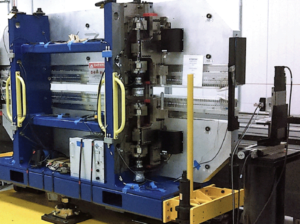 |
Shown here is a pre-production LCLS-II SXR undulator segment installed in the magnetic measurement facility at LBNL. The main features are magnetic modules and a strongback structure to position them — and move them upon command — with micron accuracy in the face of tens of thousands of kg of magnetic force. Each undulator array will consist of many 3.4 m long individual segments like this one: 32 segments for the HXR undulator; 21 for the SXR undulator.
Meanwhile, production is moving rapidly at both the magnet-systems and the mechanical-systems vendors, with four undulator segments being built at this time. Assembly of the production undulators will be split between the mechanical vendor and LBNL. The main LBNL assembly shops in Building 77 are preparing for the production run, which will begin in early 2017. |
HGVPUs Advance Through Design Phase
The design of the HGVPU (Horizontal Gap Vertically Polarized Undulator) is close to complete, and a Final Design Review is scheduled for late August. Having taken the design concept from the model prototyped by Argonne National Laboratory, the LBNL LCLS-II undulator team has implemented design changes to facilitate production, and to incorporate improved magnetic performance based on the magnetic modules successfully demonstrated on the SXR undulators. Preparations for HGVPU production procurement contracts are in an advanced state, and plans call for delivering a pre-production unit to LBNL this fall for testing.
Modeling Praised by Review Panel
The LCLS-II Facilities Advisory Committee met in July, and the LBNL team received positive comments from the expert committee. The work of the accelerator physics team in ATAP was recognized, including the use of the IMPACT codes in start-to-end modeling with global multi-objective optimization. Using this high-resolution multiphysics technique has allowed the LBNL accelerator physics team to develop linac operating configurations, giving an 80% increase in X-ray pulse energy over the best results obtained with local optimizations.
A New Phase for Low-Level RF Controls: Prototyping
The low-level RF (LLRF) controls-system design, being developed under LBNL technical leadership by a team that includes Fermilab, Jefferson Lab, and SLAC, is advancing into the prototype phase. These systems will be tested on the prototype cryomodules built at Fermilab and Jefferson lab. Testing is planned on the cold cryomodules at Fermilab in late summer, and at Jefferson Lab in the fall.
MODELING AND EXPERIMENT TIE IN FOR INTENSITY AT NDCX-II
Understanding phase transitions of materials far from equilibrium and in regimes of high temperature and pressure is important in many areas of science and technology. In astrophysics, for example, hot and highly compressed matter is found in planetary cores. This knowledge also provides foundational data that could lead to the discovery of novel materials and compounds.
This state of matter cannot be directly accessed in the natural world, so laboratory experiments (such as those which can be conducted at accelerators) are important for measuring its characteristics. The Neutralized Drift Compression Experiment II facility (NDCX-II) at Berkeley Lab, an ion accelerator, is supported by the DOE Office of Fusion Energy Science to provide unique capabilities in these fields.
 |
In recent target experiments, the 1.2 MeV He+ beam, focused to a 1-mm radius spot, with a 5 ns bunch duration, rapidly heated and ruptured a 0.4 mm thick tin foil. (The element and thickness were chosen such that the expected beam-induced heating would bring the foil near its melting temperature.)
The results show the ability of the beam to rapidly heat (and cool) materials and the ability to study material properties subject to short intense bursts of radiation damage, and, for crystalline targets, lattice disruption due to charged-particle ionizing radiation. |
Integrating Simulation and Accelerator Diagnostics Data
This achievement followed recent advances in the integration of the accelerator diagnostics with detailed particle-in-cell modeling of the beam dynamics. The particle-in-cell (PIC) code called Warp is used to simulate the beam from the source to the target and is now an integral part of data interpretation for all experiments.
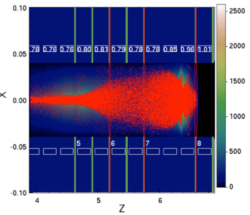 |
Recently the team connected a farm of processors running Warp to the NDCX-II data acquisition database. This allows them to directly compare measured diagnostic results to the simulation, and thus tune the accelerator to produce the conditions desired for the target experiment within minutes of acquiring the experimental data.
Warp fetches the 13 measured injector and acceleration waveforms from the most recent shots along with the 29 focusing-magnet field strengths from each shot (at about one shot per minute) to initialize a new simulation run. Shown here are simulated particle distribution, beam potential, and applied fields. |
NDCX-II is the latest application to take advantage of ATAP expertise in ion sources that use a multicusp magnetic field for plasma confinement. Initially developed in the mid-1980s in our magnetic fusion energy program, then repeatedly refined and adapted to new uses, the multicusp sources have been one of our most highly leveraged technologies. With this new helium source, NDCX-II has delivered 15-nC, 30-ns bunches within a 2-mm spot size. The beam energy is 1 MeV and the energy deposition is greater than 0.7 joules/cm2.
Training the Next Generation at NDCX-II
Undergraduate interns (l-r): Alexander Sulyman (University of California, Davis), Maya Silverman (University of California, Santa Cruz), and Eli Feinberg (Middlebury College) gained valuable hardware, software and modeling experience while working at NDCX-II this summer. They contributed very productively to several experiments (e.g., by rebuilding and aligning beam diagnostics), wrote new data analysis and instrument control software, and used software to model the experiment results.
To Learn More…
P.A. Seidl et al., “Short-pulse, compressed ion beams at the Neutralized Drift Compression Experiment,” Journal of Physics 717, 1 (2016).
AWARDS AND HONORS
Unmasking an Iron Man of USPAS
John Byrd, head of ATAP’s Center for Beam Physics, turns out to have a superhero secret identity.
At its summer session this year, the US Particle Accelerator School honored Byrd with its Iron Man Award in honor of the 13 classes he has taught over the years.
USPAS offers one- and two-week intensive short courses twice a year at various locations around the country, with undergraduate or graduate credit offered through nearby universities. The award, introduced this year, recognizes those who have taught at least a dozen USPAS classes. Byrd’s 13 classes place him behind only Mike Syphers (15) and Don Cossairt (14) among these ferric elite of accelerator education.

|
Byrd (r.) is shown here receiving his award from USPAS head, fellow Iron Man, and longtime director of ATAP’s predecessor organization AFRD, Bill Barletta.
Byrd was a student in one of the earliest university-style USPAS sessions. He first taught there in 1997 and became one of their bedrock instructors, helping develop their course on microwave measurements and beam instrumentation. He has also taught classes on accelerator-based sources of coherent terahertz radiation; accelerator and beam diagnostics; measurement and diagnostics of short bunches in accelerators; and fundamentals of accelerator physics and technology. |
ATAP’s involvement with USPAS goes back to the early days of the school. Beginning with the symposium-style programs of the 1980s and including the Joint International Particle Accelerator School, some 58 people who were, had been, or would become employees of ATAP and its predecessor organizations have taught at USPAS, for a total of at least 95 courses and lectures. Many of these courses are team-taught with colleagues from other institutions, building lasting connections throughout the accelerator community.
Two more ATAP scientists will have their first USPAS teaching experience in January: Stepan Bulanov and Carlo Benedetti will team up with their BELLA Center colleagues Carl Schroeder and Eric Esarey (both USPAS veterans) to teach “Laser-Plasma Accelerators.” Russell Wilcox and Gang Huang of the Center for Beam Physics will also return to USPAS to teach “Fundamentals of Timing and Synchronization with Applications to Accelerators.”
BELLA Center’s Vincenti Honored by ELI
Henri Vincenti, a researcher at BELLA Center, is the inaugural winner of the Wolfgang Sandner Scientific Excellence Prize for Young Researchers. He will receive the award in an August 26 ceremony at the ELI Summer School in Dolni Břežany, Czech Republic.
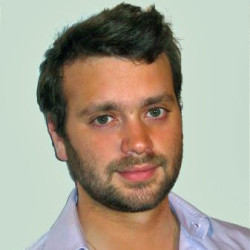
|
Vincenti was cited for his “ground-breaking contributions to ultrahigh intensity laser-plasma interaction science, as to the theoretical prediction of the attosecond lighthouse effect during his Ph.D. at CEA-LIDYL (Saclay, France) and now to the development of massively parallel solvers, essential for future exascale Particle-In-Cell simulations.”
The prize is awarded by the Extreme Light Infrastructure’s ELI Delivery Consortium International Association. Named in honor of their late Director-General, the award recognizes “outstanding instrumental, experimental or theoretical contributions to the scientific field of extreme light research and applications” by early-career scientists. |
Poster Awards at AAC for Swanson, Kirchen

|
Kelly Swanson (l.), a University of California Berkeley and BELLA Center doctoral student (research advisor, Dr. Wim Leemans; faculty advisor, Prof. Marjorie Shapiro), brought home the Student Poster Award from the Advanced Accelerator Concepts 2016 conference. Hai-En Tsai, Samuel Barber, Hann-Shin Mao, Jeroen van Tilborg, Sven Steinke, Cameron Geddes, and Wim Leemans collaborated in the work described in the poster. Swanson also gave a talk at the conference. | 
|
||
Manuel Kirchen (above, r.), a graduate student from the University of Hamburg and DESY, was honored for his poster in the Theory and Modeling category. Collaborators in the work included BELLA Center’s Rémi Lehe and Jean-Luc Vay and ATAP affiliate Brendan Godfrey of the University of Maryland.
All in all ATAP presented 7 posters, 19 talks, and 2 working-group summaries at AAC 2016.
WORKPLACE LIFE
Diversity In Hiring Task Force Recommends Action Items
Diversity in the workplace doesn’t just happen; people make it happen, using specific goals and guidelines. As part of ATAP’s commitment to improving diversity, director Wim Leemans appointed a task force in December to look into the issues and make recommendations.
 |
The ATAP Diversity in Hiring Task Force, l-r: Tamara Krake, Qing Ji (chair), Warren Byrne, Chad Mitchell, Ian Pong, Ina Reichel, and Anthony Gonsalves. |
They identified four areas for improvement:
1. Increase the diversity of the pool of potential qualified applicants
2. Improve the interview process to ensure minorities are not at a disadvantage
3. Retain diversity in our workforce
4. Make suggestions to improve Labwide policies
After discussion with the ATAP program heads, the task force issued a report with a variety of recommendations and action items. (LDAP login required.)
One prominent feature is setting up and maintaining a list of minority and women scientists in the fields relevant to the Division and using that list to share information about open positions. If you would like to contribute to this list, please contact ATAP Outreach and Education Coordinator Ina Reichel.
Other action items include inviting women and minority speakers to give seminars; suggestions regarding language in job postings; more openness in the hiring process, mentoring; and establishing regular gatherings.
Suggestions for improving diversity Labwide include encouragement of policies that are responsive to the needs of dual-career couples, as well as establishing paid parental leave.
 |
Parking Update: Winter Is Coming — Get ReadyWe have a temporary reprieve on the expected parking crisis — but only in its onset, not its inevitability. |
The start of Integrative Genomics Building construction has been delayed, likely by a few months. This means that the full brunt of parking space shortage, originally expected in August, will not be felt until this winter.
At present, about half of the Bevatron lot has been closed to allow staging activities. A map showing availability of spaces in the major parking lots will be posted at commute.lbl.gov and updated at least monthly.
Mitigating Effects of the Upcoming Parking Crunch
Suggestions from the Vehicle Access and Transportation Advisory Group (VAATAG) are being implemented. First in line is a new carpooling program.
A first batch of 30 parking spaces has been made available from 5 to 9:30 am for carpool parking, There are already several such spaces near the Cafeteria and in the vicinity of Buildings 2 and 58, an area central to the Lab and very near a shuttle-bus stop. To qualify, simply display two valid parking permits on the vehicle’s dashboard. After 9:30 am the spaces revert to general parking.
Utilization of this new program will be assessed monthly and, as those spaces fill up, more are expected to be allocated. Building managers or their designees are the points of contact for requesting more carpool spaces. Building managers for buildings with a significant ATAP population are:
Building 15: Jeff Troutman
Building 46: Michael Kritscher
Building 47: Ian Pong
Building 58: Thomas Lipton
Building 71: Pat Thomas
Let us hear from you!
No doubt about it, the upcoming parking crunch will be a problem, but with four thousand of the smartest people anywhere, surely we can figure out how to mitigate the effects. A forum has been added to commute.lbl.gov for asking questions and providing suggestions and other feedback, so let us know about your needs — and ideas!
SAFETY: THE BOTTOM LINE
Opening Our Eyes to the Risks of Drowsy Driving
Yet another reason to consider transportation alternatives is the safety concern we’re spotlighting in this issue: drowsy driving. As scientists, we push ourselves hard: caught up in experiments, troubleshooting apparatus or debugging code long into the night, making sure users get their beamtime, hurrying to the airport to catch a plane to a conference…
This takes its toll on sleep, and therefore on safety. The National Highway Traffic Safety Administration reports that simply being well rested reduces the risk of a crash by 7 percent and the risk of a fatal one by 16.5 percent. At the opposite extreme, being awake for 21 hours has an effect on an average person’s driving that is similar to being legally drunk. Insidious chronic “sleep debt” also reduces our performance both at work and behind the wheel.
The Governors Highway Safety Association has just published Wake Up Call! Understanding Drowsy Driving and What States Can Do, full of useful tips at the personal as well as the policy levels. The National Highway Traffic Safety Administration also has a comprehensive website on the subject.
Finally, consider taking public transit. It helps with the Lab’s aforementioned parking deficit, reduces traffic congestion… and if you nod off, about the worst that will happen is that you’ll miss your station. Carpooling (as long as it isn’t your turn to drive when you’re overtired) is another such way to solve multiple problems at once.

